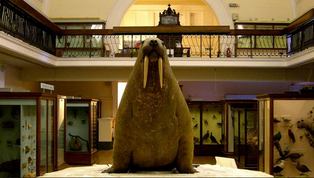
You'll find his exhibition After Life, directly opposite the Horniman’s Natural History Gallery on the Balcony Gallery. A series of square black framed photos line the two walls on either side. The dim museum lighting reminds me of the candle lit Catholic churches I was taken to as a child. The photos echo The Stations of the Cross images that line Catholic churches and while their subject matter could not be further removed, the sense of an unnatural life after death is there.
Sean has photographed taxidermy, skeletal mounts and an egg from a selection of the UK’s most amazing natural history collections from an impressive selection of institutions including the Hunterian Museums at the Royal College of Surgeons to Glasgow University's Zoology Museum. It feels like he has unearthed not only these animals but also the history of them as specimens. As the introduction states, Natural History collections are a "physical catalogue of the amazing diversity of nature" and that is the draw of these objects. They capture creatures rare and almost mythical in their extinction.
| The exhibition starts with a show stopper of a specimen. The Victoria Crowned-pigeon's plumage lives up to its name. The regal blue and fine strands of the feathers cross over in a pattern so beautiful you can imagine human trying to weave a costume to mimic its splendour. | the photographs convey the absence of life. The grey backgrounds are deliberately muted. a bright white surface now covered in dust and patina |
The specimens on display were accompanied by their common name, Latin name and then a spectrum of terms I was not completely familiar with and I spent a long time deciding on their running order. I'm still unsure so here they all are; Vulnerable, Extinct, Critically Endangered, Endangered, Brink of Extinction and finally the unreassuring, Least Concern.
The Song Thrush is 50% down in population in the UK recent years but still going strong. A warning maybe? This photo was soon followed by a series of four all of the same species but of four different specimens from three different sources. Another warning and possibly a reason why the lovely green Kakapo is critically endangered, so many stuffed and hidden away in collections across Britain, some not so hidden.
In the centre of the balcony when you walk into the gallery, you see the striking 'Object in Focus' case. Lit from its corners, this singular case exhibition showcases one of hundreds of thousands of collected by the Horniman that have never displayed before.
This additional exhibition compliments the photos and gives you a real three dimensional experience of the taxidermy captured in Dooley’s photographic series. The Kakapo "The Parrot of the Night" doesn't just have a catchy name and tagline, its place as "one of the world's rarest and most unusual parrots" instantly makes you understand why the hunters and natural historians of the Victorian era coveted them so much and how beings can become to be so rare in the first place.
The odd after life of taxidermy animals is so clearly exhibited in Dooley's images. The photographs convey the absence of life. The grey backgrounds are deliberately muted. A bright white surface now covered in dust and patina, these feathers and furs have lost their freshness and lustre. The drying furs and faded feathers replace the natural oils and vivid hues only seen in the living. Taxidermy is a reminiscence of life and its unnatural state is an everlasting reminder of man's interference with nature. After Life allows you to look closely at this.
Squeamish Nicola
After Life runs from September 28th 2013 – March 2nd 2014


 RSS Feed
RSS Feed
